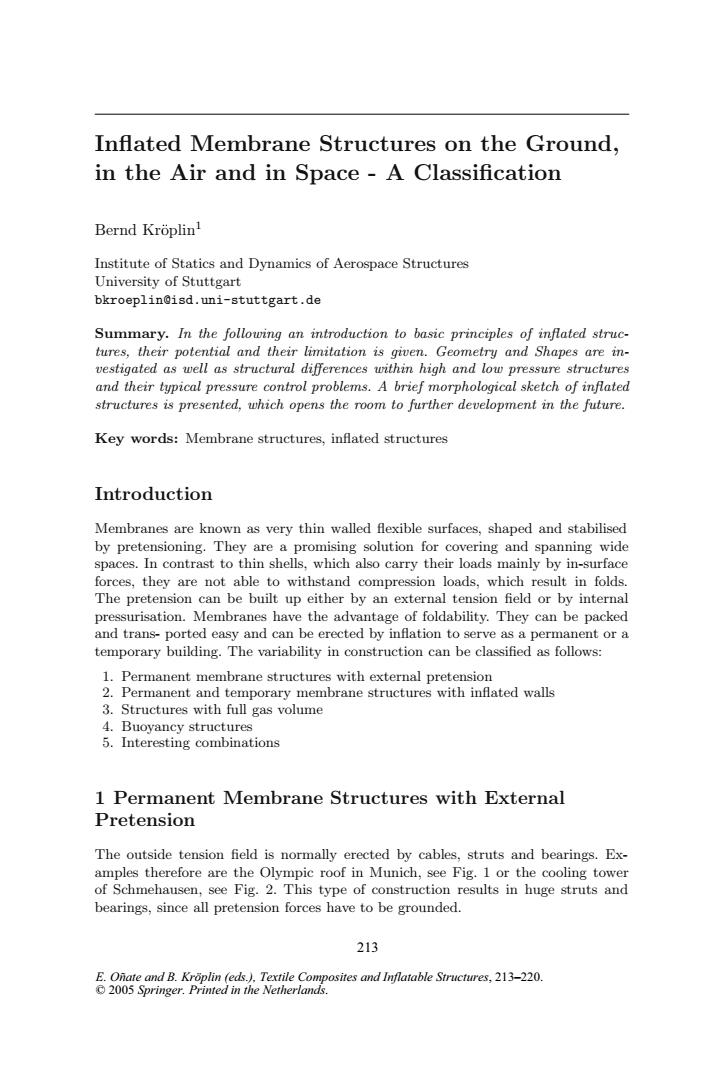正在加载图片...

Inflated Membrane Structures on the Ground, in the Air and in Space -A Classification Bernd Kroplin Institute of Statics and Dynamics of Aerospace Structures University of Stuttgart bkroeplinQisd.uni-stuttgart.de Summary.In the following an introduction to basic principles of inflated struc- tures,their potential and their limitation is given.Geometry and Shapes are in- vestigated as well as structural differences within high and low pressure structures and their typical pressure control problems.A brief morphological sketch of inflated structures is presented,which opens the room to further development in the future. Key words:Membrane structures,inflated structures Introduction Membranes are known as very thin walled flexible surfaces,shaped and stabilised by pretensioning.They are a promising solution for covering and spanning wide spaces.In contrast to thin shells,which also carry their loads mainly by in-surface forces,they are not able to withstand compression loads,which result in folds. The pretension can be built up either by an external tension field or by internal pressurisation.Membranes have the advantage of foldability.They can be packed and trans-ported easy and can be erected by inflation to serve as a permanent or a temporary building.The variability in construction can be classified as follows: 1.Permanent membrane structures with external pretension 2.Permanent and temporary membrane structures with inflated walls 3.Structures with full gas volume 4.Buoyancy structures 5.Interesting combinations 1 Permanent Membrane Structures with External Pretension The outside tension field is normally erected by cables,struts and bearings.Ex- amples therefore are the Olympic roof in Munich,see Fig.1 or the cooling tower of Schmehausen,see Fig.2.This type of construction results in huge struts and bearings,since all pretension forces have to be grounded. 213 E.Onate and B.Kroplin (eds.).Textile Composites and Inflatable Structures,213-220. 2005 Springer.Printed in the Netherlands.Inflated Membrane Structures on the Ground, in the Air and in Space - A Classification Bernd Kr¨plin o 1 Institute of Statics and Dynamics of Aerospace Structures University of Stuttgart bkroeplin@isd.uni-stuttgart.de Summary. In the following an introduction to basic principles of inflated structures, their potential and their limitation is given. Geometry and Shapes are investigated as well as structural differences within high and low pressure structures and their typical pressure control problems. A brief morphological sketch of inflated structures is presented, which opens the room to further development in the future. Key words: Membrane structures, inflated structures Introduction Membranes are known as very thin walled flexible surfaces, shaped and stabilised by pretensioning. They are a promising solution for covering and spanning wide spaces. In contrast to thin shells, which also carry their loads mainly by in-surface forces, they are not able to withstand compression loads, which result in folds. The pretension can be built up either by an external tension field or by internal pressurisation. Membranes have the advantage of foldability. They can be packed and trans- ported easy and can be erected by inflation to serve as a permanent or a temporary building. The variability in construction can be classified as follows: 1. Permanent membrane structures with external pretension 2. Permanent and temporary membrane structures with inflated walls 3. Structures with full gas volume 4. Buoyancy structures 5. Interesting combinations 1 Permanent Membrane Structures with External Pretension The outside tension field is normally erected by cables, struts and bearings. Examples therefore are the Olympic roof in Munich, see Fig. 1 or the cooling tower of Schmehausen, see Fig. 2. This type of construction results in huge struts and bearings, since all pretension forces have to be grounded. 213 E. Oñate and B. Kröplin (eds.), Textile Composites and Inflatable Structures, 213–220. © 2005 Springer. Printed in the Netherlands